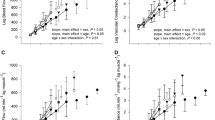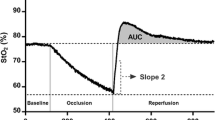Abstract
This study examined the relation between femoral artery hyperemic responses to leg exercise and microvascular oxygen extraction in nine young [(mean ± S.E.M) Y: 25 ± 1 years] and 13 older (O: 67 ± 1 years) healthy women. Femoral artery blood flow (FBF; Doppler ultrasound), mean arterial pressure (MAP), and femoral vascular conductance (FVC; FBF/MAP) were assessed at rest and during 9 min of ∼17–18 W single knee extensor exercise. Near-infrared spectroscopy (NIRS) in the vastus lateralis was used to measure changes in deoxyhemoglobin (HHb) and oxyhemoglobin (O2Hb) to assess oxygen extraction (Δ HHb), microvascular blood volume (Δ HHb + O2Hb), and spatial heterogeneity of blood volume (relative dispersion, defined as the coefficient of variation of measurements from all NIR sensors). During exercise, FBF and FVC were lower (p < 0.05) in O compared to Y (Y: 1,430 ± 101 mL min−1 and 16.6 ± 1.2 mL min−1 per mmHg versus O: 1,127 ± 64 mL min−1 and 10.9 ± 0.6 mL min−1per mmHg). While oxygen extraction increased more rapidly in Y, there were no age differences (p > 0.10) beyond the fourth min of exercise. In addition, the relative increase in microvascular blood volume was not significantly different during exercise in Y versus O (age effect: p = 0.87), although Y demonstrated an increase in blood volume heterogeneity in both the active and inactive leg (p = 0.02 and <0.05, respectively) not observed in O (p = 0.71 and 0.28, respectively). NIRS-derived measurements of changes in deoxygenated hemoglobin do not support the hypothesis that older women compensate for the blunted leg hyperemic response to knee extensor exercise through an augmentation of quadriceps oxygen extraction; knee extensor work may be accomplished by other metabolic or microvascular adjustments to exercise in older women.



Similar content being viewed by others
References
ACSM (2006) ACSM’s Guidelines for Exercise Testing and Prescription . Lippincott Williams and Wilkins, Philadelphia
Baecke JA, Burema J, Frijters JE (1982) A short questionnaire for the measurement of habitual physical activity in epidemiological studies. Am J Clin Nutr 36:936–942
Bauer TA, Reusch JE, Levi M, Regensteiner JG (2007) Skeletal muscle deoxygenation after the onset of moderate exercise suggests slowed microvascular blood flow kinetics in type 2 diabetes. Diabetes Care 30:2880–2885
Bearden SE, Payne GW, Chisty A, Segal SS (2004) Arteriolar network architecture and vasomotor function with ageing in mouse gluteus maximus muscle. J Physiol 561:535–545
Beere PA, Russell SD, Morey MC, Kitzman DW, Higginbotham MB (1999) Aerobic exercise training can reverse age-related peripheral circulatory changes in healthy older men. Circulation 100:1085–1094
Behnke BJ, Prisby RD, Lesniewski LA, Donato AJ, Olin HM, Delp MD (2006) Influence of ageing and physical activity on vascular morphology in rat skeletal muscle. J Physiol 575:617–626
Belardinelli R, Barstow TJ, Porszasz J, Wasserman K (1995) Skeletal muscle oxygenation during constant work rate exercise. Med Sci Sports Exerc 27:512–519
Coggan AR, Spina RJ, King DS, Rogers MA, Brown M, Nemeth PM, Holloszy JO (1992) Histochemical and enzymatic comparison of the gastrocnemius muscle of young and elderly men and women. J Gerontol 47:B71–76
Conley KE, Jubrias SA, Esselman PC (2000) Oxidative capacity and ageing in human muscle. J Physiol 526 (Pt 1):203–210
De Blasi RA, Ferrari M, Natali A, Conti G, Mega A, Gasparetto A (1994) Noninvasive measurement of forearm blood flow and oxygen consumption by near-infrared spectroscopy. J Appl Physiol 76:1388–1393
DeLorey DS, Kowalchuk JM, Paterson DH (2003) Relationship between pulmonary O2 uptake kinetics and muscle deoxygenation during moderate-intensity exercise. J Appl Physiol 95:113–120
DeLorey DS, Paterson DH, Kowalchuk JM (2007) Effects of ageing on muscle O2 utilization and muscle oxygenation during the transition to moderate-intensity exercise. Appl Physiol Nutr Metab 32:1251–1262
Dipietro L, Caspersen CJ, Ostfeld AM, Nadel ER (1993) A survey for assessing physical activity among older adults. Med Sci Sports Exerc 25:628–642
Donato AJ, Uberoi A, Wray DW, Nishiyama S, Lawrenson L, Richardson RS (2006) Differential effects of aging on limb blood flow in humans. Am J Physiol Heart Circ Physiol 290:H272–278
Ferrari M, Binzoni T, Quaresima V (1997) Oxidative metabolism in muscle. Philos Trans R Soc Lond B Biol Sci 352:677–683
Ferri A, Adamo S, Longaretti M, Marzorati M, Lanfranconi F, Marchi A, Grassi B (2007) Insights into central and peripheral factors affecting the “oxidative performance” of skeletal muscle in aging. Eur J Appl Physiol 100:571–579
Fuglevand AJ, Segal SS (1997) Simulation of motor unit recruitment and microvascular unit perfusion: spatial considerations. J Appl Physiol 83:1223–1234
Heinonen IH, Nesterov SV, Kemppainen JT, Nuutila P, Knuuti J, Laitio R, Kjaer M, Boushel R, Kalliokoski KK (2007) Role of adenosine in regulating the heterogeneity of skeletal muscle blood flow during exercise in humans. J Appl Physiol 103:2042–2048
Homma S, Fukunaga T, Kagaya A (1996) Influence of adipose tissue thickness on near infrared spectroscopic signals in the measurement of human muscle. J Biomed Opt 1:418–424
Kalliokoski KK, Oikonen V, Takala TO, Sipila H, Knuuti J, Nuutila P (2001) Enhanced oxygen extraction and reduced flow heterogeneity in exercising muscle in endurance-trained men. Am J Physiol Endocrinol Metab 280:E1015–1021
Kalliokoski KK, Scheede-Bergdahl C, Kjaer M, Boushel R (2006) Muscle perfusion and metabolic heterogeneity: insights from noninvasive imaging techniques. Exerc Sport Sci Rev 34:164–170
Lanza IR, Larsen RG, Kent-Braun JA (2007) Effects of old age on human skeletal muscle energetics during fatiguing contractions with and without blood flow. J Physiol 583:1093–1105
Lawrenson L, Poole JG, Kim J, Brown C, Patel P, Richardson RS (2003) Vascular and metabolic response to isolated small muscle mass exercise: effect of age. Am J Physiol Heart Circ Physiol 285:H1023–1031
Lundgren F, Bennegard K, Elander A, Lundholm K, Schersten T, Bylund-Fellenius AC (1988) Substrate exchange in human limb muscle during exercise at reduced blood flow. Am J Physiol 255:H1156–1164
MacDonald MJ, Tarnopolsky MA, Green HJ, Hughson RL (1999) Comparison of femoral blood gases and muscle near-infrared spectroscopy at exercise onset in humans. J Appl Physiol 86:687–693
Magnusson G, Kaijser L, Sylven C, Karlberg KE, Isberg B, Saltin B (1997) Peak skeletal muscle perfusion is maintained in patients with chronic heart failure when only a small muscle mass is exercised. Cardiovasc Res 33:297–306
Mancini DM, Bolinger L, Li H, Kendrick K, Chance B, Wilson JR (1994) Validation of near-infrared spectroscopy in humans. J Appl Physiol 77:2740–2747
Musch TI, Eklund KE, Hageman KS, Poole DC (2004) Altered regional blood flow responses to submaximal exercise in older rats. J Appl Physiol 96:81–88
Parker BA, Smithmyer SL, Pelberg JA, Mishkin AD, Herr MD, Proctor DN (2007) Sex differences in leg vasodilation during graded knee extensor exercise in young adults. J Appl Physiol 103:1583–1591
Parker BA, Smithmyer SL, Pelberg JA, Mishkin AD, Proctor DN (2008) Sex-specific Influence of Aging on Exercising Leg Blood Flow. J Appl Physiol 104:655–664
Poole DC, Wagner PD, Wilson DF (1995) Diaphragm microvascular plasma PO2 measured in vivo. J Appl Physiol 79:2050–2057
Poole JG, Lawrenson L, Kim J, Brown C, Richardson RS (2003) Vascular and metabolic response to cycle exercise in sedentary humans: effect of age. Am J Physiol Heart Circ Physiol 284:H1251–1259
Proctor DN, Koch DW, Newcomer SC, Le KU, Leuenberger UA (2003) Impaired leg vasodilation during dynamic exercise in healthy older women. J Appl Physiol 95:1963–1970
Proctor DN, Le KU, Ridout SJ (2005) Age and regional specificity of peak limb vascular conductance in men. J Appl Physiol 98:193–202
Proctor DN, Shen PH, Dietz NM, Eickhoff TJ, Lawler LA, Ebersold EJ, Loeffler DL, Joyner MJ (1998) Reduced leg blood flow during dynamic exercise in older endurance-trained men. J Appl Physiol 85:68–75
Richardson RS, Poole DC, Knight DR, Kurdak SS, Hogan MC, Grassi B, Johnson EC, Kendrick KF, Erickson BK, Wagner PD (1993) High muscle blood flow in man: is maximal O2 extraction compromised? J Appl Physiol 75:1911–1916
Roach RC, Koskolou MD, Calbet JA, Saltin B (1999) Arterial O2 content and tension in regulation of cardiac output and leg blood flow during exercise in humans. Am J Physiol 276:H438–445
Rowell LB, Saltin B, Kiens B, Christensen NJ (1986) Is peak quadriceps blood flow in humans even higher during exercise with hypoxemia? Am J Physiol 251:H1038–H1044
Short KR, Vittone JL, Bigelow ML, Proctor DN, Coenen-Schimke JM, Rys P, Nair KS (2005) Changes in myosin heavy chain mRNA and protein expression in human skeletal muscle with age and endurance exercise training. J Appl Physiol 99:95–102
van Beekvelt MC, Borghuis MS, van Engelen BG, Wevers RA, Colier WN (2001) Adipose tissue thickness affects in vivo quantitative near-IR spectroscopy in human skeletal muscle. Clin Sci (Lond) 101:21–28
Van Beekvelt MC, Colier WN, Wevers RA, Van Engelen BG (2001) Performance of near-infrared spectroscopy in measuring local O(2) consumption and blood flow in skeletal muscle. J Appl Physiol 90:511–519
Wahren J, Saltin B, Jorfeldt L, Pernow B (1974) Influence of age on the local circulatory adaptation to leg exercise. Scand J Clin Lab Invest 33:79–86
Walley KR (1996) Heterogeneity of oxygen delivery impairs oxygen extraction by peripheral tissues: theory. J Appl Physiol 81:885–894
Williams MR, Westerman RA, Kingwell BA, Paige J, Blombery PA, Sudhir K, Komesaroff PA (2001) Variations in endothelial function and arterial compliance during the menstrual cycle. J Clin Endocrinol Metab 86:5389–5395
Wilson JR, Mancini DM, McCully K, Ferraro N, Lanoce V, Chance B (1989) Noninvasive detection of skeletal muscle underperfusion with near-infrared spectroscopy in patients with heart failure. Circulation 80:1668–1674
Acknowledgments
We thank the GCRC clinicians and staff as well as Michael D. Herr, Doug Johnson, and Denny Ripka for their assistance with data collection. This research was supported by R01 AG18246 (D.N. Proctor), NIA Interdisciplinary Training in Gerontology Grant T32 AG00048 (B.A. Parker) and M01 RR10732 (GCRC).
Author information
Authors and Affiliations
Corresponding author
Rights and permissions
About this article
Cite this article
Parker, B.A., Smithmyer, S.L., Ridout, S.J. et al. Age and microvascular responses to knee extensor exercise in women. Eur J Appl Physiol 103, 343–351 (2008). https://doi.org/10.1007/s00421-008-0711-0
Accepted:
Published:
Issue Date:
DOI: https://doi.org/10.1007/s00421-008-0711-0




